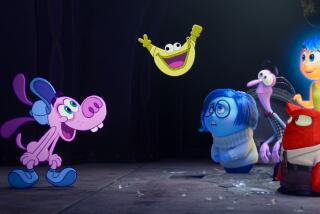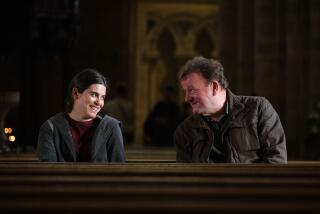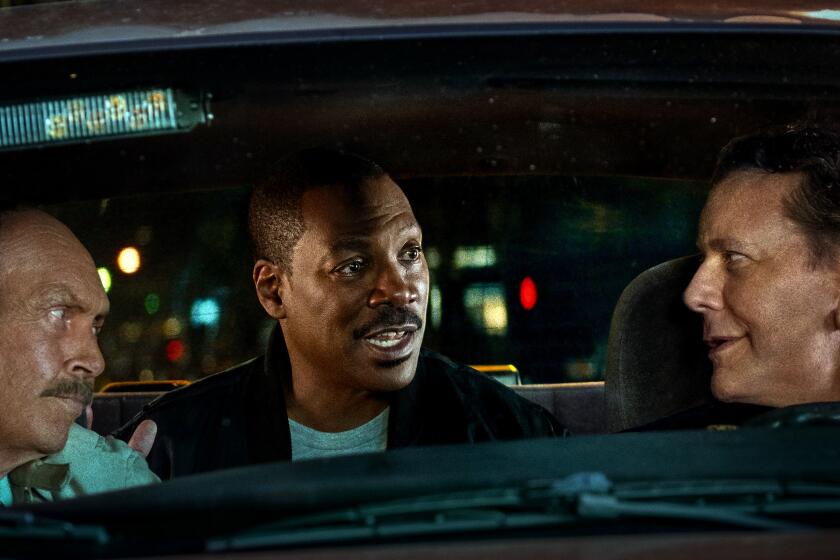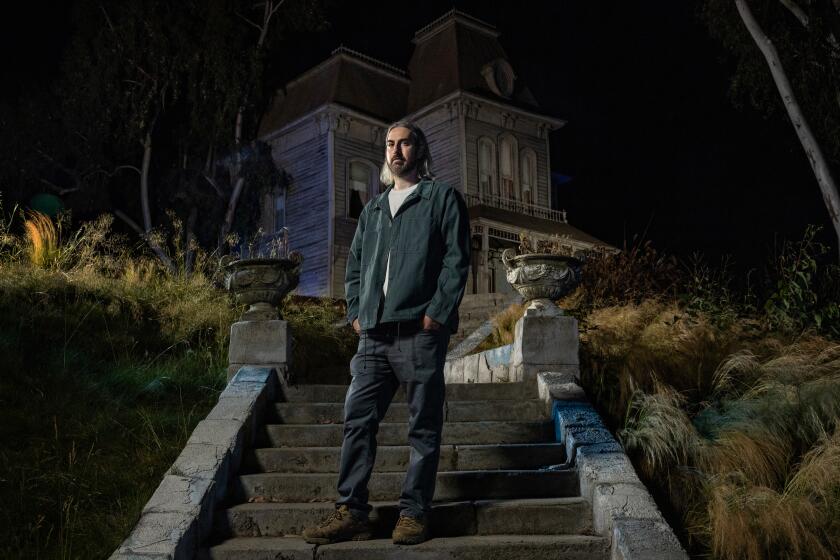Dana Andrews Dies; Actor Was a Success but Not a Star
Dana Andrews, whose film portrayals ranged from a sensitive, tough-talking detective in the 1944 movie “Laura” to a bombardier returning to a troubled civilian life in the post-World War II classic “The Best Years of Our Lives,” died Thursday.
His brother, actor Steve Forrest, said Andrews had been in failing health for several weeks and was 83 when he died at Los Alamitos Medical Center of congestive heart failure and pneumonia.
Despite the critical and public acclaim he drew with his “Laura” and “Best Years” performances and a third in a supporting but significant role in “The Ox-Bow Incident,” Andrews generally starred in moderate-budget films, making more than 70 of them. Eventually he turned to real estate development when he grew too old to be cast as a hero.
One of the reasons his acting career did not blossom into full-fledged stardom, he admitted later in his life, was his propensity for liquor.
He not only admitted the problem but went public with his alcoholism, becoming a member of the National Council on Alcoholism and making numerous appearances to talk about his struggle with the disease.
“No one ever said anything to me about my drinking,” he once told an interviewer. “But word gets around, and the pictures dried up. It was (Samuel) Goldwyn who finally said to me, ‘Look, young man, you’re drinking far too much. You’d better cut it out’.”
He became part of a national movement to make people aware of the pitfalls of drink. In 1981, when the news media and then-Los Angeles County Coroner Thomas Noguchi were being roundly criticized for reporting that the deaths of film stars Natalie Wood and William Holden were alcohol-related, Andrews held a news conference to say that to “soft-pedal” such tragedies would be a tragedy of its own.
“There is every likelihood Bill (a former drinking companion of Andrews) and Natalie would be alive today if it were not for alcohol,” he said.
Unlike some years of his private life, on the screen Andrews always appeared to be in perfect control of himself, delivering his lines in a resonant baritone that had been his ticket to Hollywood.
He was born Carver Dana Andrews in Dont, Miss., one of 13 children of a Baptist minister. He majored in business administration at Sam Houston State Teachers College in Huntsville, Tex., but left school in 1929 to take a job with a Texas oil company.
In 1931, with the Depression at its height, he quit, spending all his money for a black alpaca trench coat, a white silk scarf and a homburg hat. He then hitchhiked to Los Angeles to try to break into the movies.
“When I got there,” he was to recall, “the most glamorous job I could get was driving a school bus for $10 a week. I wound up pumping gas in Van Nuys. Hell, everyone wanted to be an actor then. Everyone wanted to get into those studio gates.”
He worked at other jobs--driving a truck, digging ditches, picking oranges and working in a department store stock room. He was turned down by all the film studios and by the Pasadena Playhouse, then a prime training center for aspiring actors and actresses.
He borrowed money from friends to take opera lessons, but an agent heard him sing and advised him to stick with acting. Andrews applied to Pasadena Playhouse again and, for reasons no longer clear, was accepted. He began as a spear carrier in a Shakespearean drama.
In 1932, he married Janet Murray. They had a son, David, who was to become a pianist, organist, composer and radio announcer. He died in 1964 at age 30 of a cerebral hemorrhage. The actor’s wife died in 1935.
It was not until 1938 that Andrews got a film contract, with Goldwyn. But he was given no roles until two years later, when he was cast in a minor part in “The Westerner,” starring Gary Cooper.
On the strength of that, Andrews married another Pasadena Playhouse student, Mary Todd. They were to have two daughters, Katherine and Susan, and a son, Stephen, who survive him along with three grandchildren and three other brothers.
Goldwyn sold half of Andrews’ contract to 20th Century Fox and for three years he went back and forth between the two studios, in secondary roles in such films as “Sailor’s Lady” (1940), “Tobacco Road” (1941), “Belle Starr” (1941), “Swamp Water” (1941), “The North Star” (1941) and “The Ox-Bow Incident” (1943).
In 1943 he suddenly won the romantic lead in the Danny Kaye comedy “Up in Arms” and a starring role in “The Purple Heart,” about the Jimmy Doolittle raid on Tokyo. In 1944, he played the lead in still another war movie, “Wing and a Prayer.”
Then came his big break--”Laura.” It was important, too, in the careers of co-star Gene Tierney and of actors Clifton Webb and Vincent Price. The story of a cynical detective falling in love with a portrait of a supposed murder victim became a classic and seemed to vault Dana Andrews to a level of stardom that he would inhabit for the rest of his career.
Price reflected on “Laura” Thursday after being told of his old friend’s death:
“It was a strange film to make. We started with one director and changed in the middle of the picture . . . had to reshoot everything.
“But we all knew it was a wonderful script and it was going to make a great film. I worked with Dana again, in a picture called ‘While the City Sleeps.’ He had an extraordinary quality--sort of the original type of leading man we’ve come to depend on in the movie business.
“I’m so sad he’s gone.”
But even though Andrews became a popular star, he never again got sweeping applause. The closest he came was in the 1946 film “The Best Years of Our Lives,” which won seven Academy Awards (Andrews was not nominated).
After that movie, Andrews slipped back into such medium-budget features as “Boomerang,” “Night Song,” “Daisy Kenyon,” “Deep Waters,” “The Iron Curtain” and “Forbidden Street.”
In 1952, with his studio contracts expired, he began to free-lance and formed his own production company, Lawrence Productions. His 1954 credits included “Elephant Walk” and “Duel in the Jungle.”
By the late 1950s, work was increasingly harder to get. He was typed as a young hero, but he no longer looked the part. His hair was turning white and producers--faced with the competition of television--were cutting back on the medium-budget films in favor of more lavish pictures. “They want top box office names for blockbusters and I’m not in that category,” he told a reporter.
In 1952 he had toured with his wife doing the stage play “The Glass Menagerie,” but it was not until 1958 that he was offered the role of the Omaha lawyer in the Broadway show “Two for the Seesaw,” replacing Henry Fonda. He stayed in the play for a year, co-starring with Anne Bancroft. It briefly revitalized his career.
After that, he and his family moved back to Toluca Lake. In 1963, he was elected president of the Screen Actors Guild.
He was beginning to make money in real estate development. He got the idea after simply reading a book. By 1964 he and a partner had completed an apartment house in Garden Grove and by 1982, he was able to tell an interviewer:
“I’m retired now. I’ve made all the money I want. So I just do what I feel like doing. If I act again, it has to be something meaningful.” He said he was earning more “with all my apartment buildings and hotels than I ever did when I was a movie star.”
Although he spent four years in the cast of a daytime soap opera, “Bright Promise,” did an occasional television drama or appeared in dinner theater with his wife, Andrews had faded from stardom.
Asked once to name the film he had enjoyed doing most, Andrews could not. “I simply love this business,” he replied. “That’s all.”
Funeral services will be private. His family asks contributions in his name to the American Heart Assn. or the Motion Picture Fund.
More to Read
Only good movies
Get the Indie Focus newsletter, Mark Olsen's weekly guide to the world of cinema.
You may occasionally receive promotional content from the Los Angeles Times.






